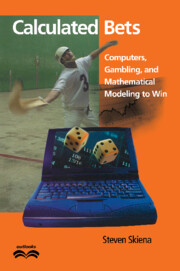Book contents
- Frontmatter
- Contents
- Preface
- Acknowledgments
- 1 The Making of a Gambler
- 2 What Is Jai Alai?
- 3 Monte Carlo on the Tundra
- 4 The Impact of the Internet
- 5 Is This Bum Any Good?
- 6 Modeling the Payoffs
- 7 Engineering the System
- 8 Putting My Money Where My Mouth Is
- 9 How Should You Bet?
- 10 Projects to Ponder
- Glossary
- For Further Reading
- Index
10 - Projects to Ponder
Published online by Cambridge University Press: 17 August 2009
- Frontmatter
- Contents
- Preface
- Acknowledgments
- 1 The Making of a Gambler
- 2 What Is Jai Alai?
- 3 Monte Carlo on the Tundra
- 4 The Impact of the Internet
- 5 Is This Bum Any Good?
- 6 Modeling the Payoffs
- 7 Engineering the System
- 8 Putting My Money Where My Mouth Is
- 9 How Should You Bet?
- 10 Projects to Ponder
- Glossary
- For Further Reading
- Index
Summary
Mathematical modeling is a subject best appreciated by doing. The trick is finding an interesting type of prediction to make or question to study, and then identifying sufficient data to build a reasonable model upon. Even if you are not a computer programmer, spread-sheet programs such as Microsoft Excel can provide an excellent environment in which to experiment with mathematical models.
In this section, I pose several interesting questions to which the modeling techniques presented in this book may be applicable. To provide starting points, I include links to existing studies and data sets on the WWW. Web links are extremely perishable, so treat these only as an introduction. Any good search engine like www.google.com should help you find better sources after a few minutes' toil. Happy modeling!
Gambling
Lottery numbers – How random are lottery numbers? Do certain numbers in certain states come up more often than would be expected by chance? Can you predict which lotto combinations are typically underbet, meaning that they minimize the likelihood that you must share the pot with someone else if you win?. How large must pool size grow in a given progressive lottery to yield a positive expected value for each ticket bought?
Plenty of lottery records are available on the WWW if you look hard enough. Log on to http://www.lottonet.com/ for several year's historical data from several state lotteries. Minnesota does a particularly good job, making its historical numbers available at http://www.lottery.state.mn.us.
Horse racing – Many of the ideas employed in our jai alai system are directly applicable to horse racing. […]
- Type
- Chapter
- Information
- Calculated BetsComputers, Gambling, and Mathematical Modeling to Win, pp. 209 - 214Publisher: Cambridge University PressPrint publication year: 2001

